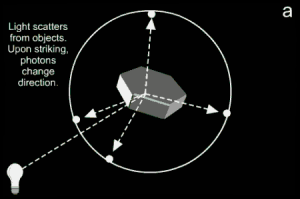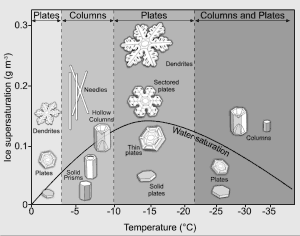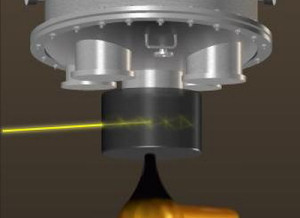Cloud Physics Research - Light Scattering by Ice Crystals
by Dr. Christopher Emersic

Click on the figure to see the full series.
A possible upcoming project involving the Manchester Ice Cloud Chamber (MICC) will investigate the light scattering properties of ice crystals. As light waves strike an ice crystal, they can be deflected and travel in a different direction. This scattering direction is not always the same, but over time, with many such light scattering events, a general scattering pattern (scattering phase function) is produced (Fig. 1). The nature of this pattern is determined by the ice crystal’s size and shape and also on the wavelength of incident light. The crystal’s size and shape are in turn determined by the environment in which they are growing; crystals grown at different temperatures for example have different shapes (habits) as shown in the morphology diagram (Fig. 2).
An understanding of the scattering of light by ice crystals is important in many areas. Firstly, correctly knowing how much of the incoming solar radiation is reflected back into space has important consequences for studies of climate change. Clouds containing crystals of a type which reflect a lot of this radiation (constituting high albedo clouds) can contribute a net Earth cooling effect; in fact the cooling effect of ice clouds on the Earth’s radiation budget is understood to be comparable to the heating effect of the greenhouse gases and is therefore an important area to understand. Knowing how the scattering phase function varies with crystal cloud type will allow the validation of scattering models used in climate studies.

This work is also important in the development of numerical models relating to the use of light detection and ranging (LIDAR) technology. It is hoped that these models can benefit from a better understanding of the scattering of light of a particular wavelength associated with the LIDAR devices. A LIDAR is a form of radar which emits a beam of light into clouds of shorter wavelength (infrared, 1.5 µm) than most conventional radars. The beam is scattered by the cloud particles, and what is returned is used to infer cloud properties. It is hoped that models to determine the actual particle sizes can be developed from a better understanding of the scattering properties of a range of ice clouds when infrared light is incident.
Of particular interest in relation to studies of climate change is the effect that ice crystal aggregates have on scattering. Studies (e.g. Connolly et al., 2005) have shown lots of aggregate particles (long chains of connected crystals) in the anvils of thunderstorms, in particular, the aggregation of horizontally aligned plate crystals which act like small mirrors and generate highly reflective clouds. Such storms and associated anvils are situated in equatorial regions, where the greatest input of solar radiation to the Earth’s heat system occurs, and where it is thus particularly important to understand the scattering properties of such ice clouds.
The MICC facility allows the production of crystals with a wide range of sizes and habits for examination, and uniquely, the production of aggregate particles, thanks to its 10 m height, which provides the fall-time for crystals to stick together. A multi-wavelength tuneable laser will provide a high powered light source to enhance the otherwise feint scattering signals, allowing a quick (<1 s) determination of the scattering phase functions of the crystals.

Experimental procedures will generally involve generating a crystal cloud with desired properties, which will then be introduced to a motorised scattering chamber (Fig. 3). A light source shining into the scattering chamber will interact with the cloud, and the resulting scattering phase function will be measured. The constituent cloud particles are measured with the CPI for later comparison with the scattering phase function.
References:
Connolly, P. J., C. P. R. Saunders, M. W. Gallagher, K. N. Bower, M. J. Flynn, T. W. Choularton, J. Whiteway, and P. Lawson, 2005: Aircraft observations of the influence of electric fields on the aggregation of ice crystals. Quart. J. Roy. Meteor. Soc., 131, 1695–1712.
Heymsfield, A. J., and G. M. McFarquhar, 1996: High albedos of cirrus in the tropical pacific warm pool: Microphysical interpretations from CEPEX and from Kwajalein, Marshall Islands. J. Atmos. Sci., 53(17), 2424–2451.
McFarquhar, G. M., U. Junshik, M. Freer, D. Baumgardner, G. L. Kok, and G. Mace, 2007: Importance of small ice crystals to cirrus properties: Observations from the tropical warm pool international cloud experiment (twp-ice). Geophys. Res. Lett., 34, 13,803–.
Stephens, G. L., S. Tsay, P. W. Stackhouse, and P. J. Flatau, 1990: The relevance of the microphysical and radiative properties of cirrus clouds to climate and climatic feedback. J. Atmos. Sci., 47, 1742–1753.
Um, J., and G. M. McFarquhar, 2009: Single-scattering properties of aggregates of plates. Quart. J. Roy. Meteor. Soc., 135, 291–304.